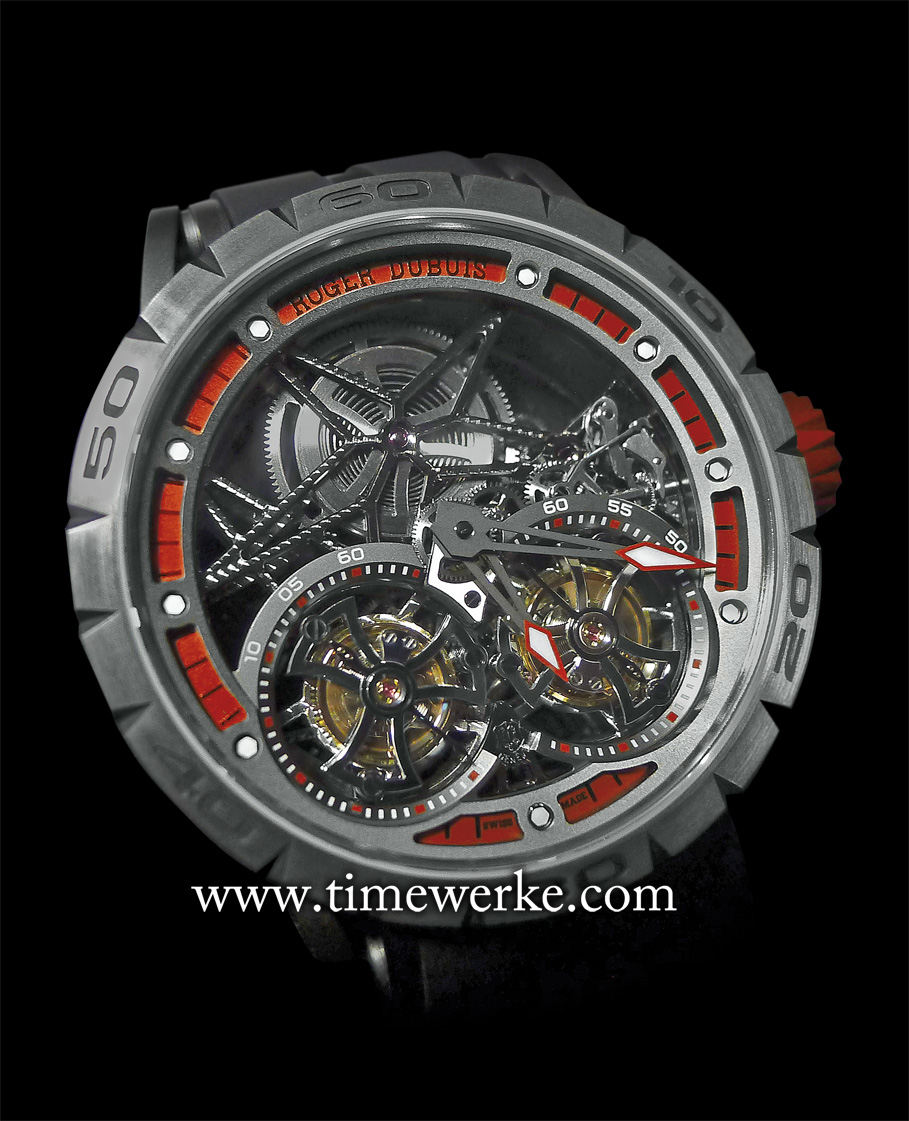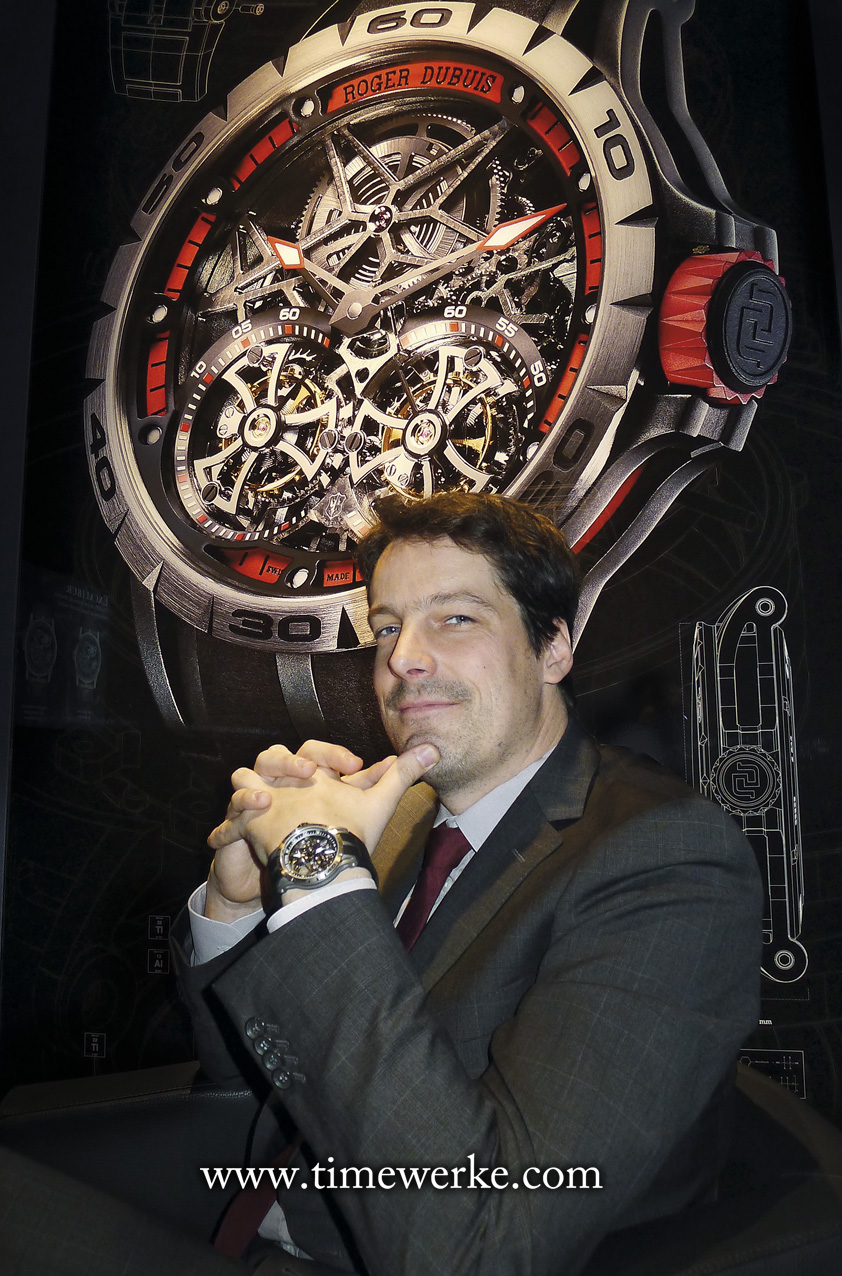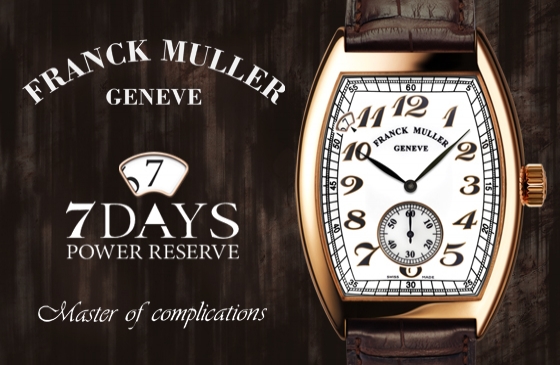
Roger Dubuis Excalibur Spider Skeleton Double Flying Tourbillon. Introduced in 2015, it is powered by the RD01SQ manual-winding movement and bears the Poinçon de Genève (Geneva Seal Hallmark). The Calibre RD01SQ manual-winding movement features the double flying tourbillon with differentials at 4.30 and 7.30, each tourbillon carriage completing one rotation every 60 seconds. The movement comprises 301 components. Besides the movement, the hands, flange and 47mm diameter case in black DLC titanium are also skeletonized. This watch has a red aluminium container and red crown. Limited to 188 pieces. Photo: © TANG Portfolio. Elfa / Timmy. 2015 Salon International de la Haute Horlogerie.
At the 25th edition of the Salon International de la Haute Horlogerie held in Geneva, Roger Dubuis declared 2015 the “Year of the Astral Skeleton”, notably for its Excalibur collection.
This is understandable as it also marks the tenth year anniversary of the first Excalibur skeleton watch. After all, it was only in 2005 that the brand first launched its Excalibur collection.
The Excalibur was actually the name given to a new case design by Carlos Diaz, the founder and former president of Roger Dubuis.
In 2005, besides the super high-complications presented, namely the Calibre RD01 double tourbillon in the Excalibur 01 and the Calibre RD08 minute repeater tourbillon in the Excalibur 08, the brand also presented its Calibre RD02 skeleton movement.
The brand continually refined its skeleton movements and in 2009, Roger Dubuis presented the sculptural version of its double tourbillon: the Excalibur Skeleton Double Tourbillon.
From what we understand, development on this skeleton double tourbillon had begun as early as in 2001 and Roger Dubuis is the only brand on the market that has a double tourbillon skeleton wristwatch.
In just a short period of over a decade, Roger Dubuis has firmly established itself as the pioneer of skeleton calibres.
The highly technical timepieces for its 2015 skeleton models have the word “Spider” included, a code name given. These are the Excalibur Spider Skeleton Double Flying Tourbillon and the Excalibur Spider Skeleton Flying Tourbillon which also comes with a version where the bezel features diamonds set on rubber.
Why the code name “spider”? That is because cobwebs spun by spiders to trap their prey can have exceptionally strong structures.
The webs spun by the Nephila spiders found in the warmer climates of Asia, Australia and the Americas for example, are so strong that natives in Papua New Guinea use them to produce fishing nets for small fish or fishing lines for larger catches, according to E. Sue Andersen in her research article, Captive Breeding and Husbandry of the Golden Orb Weaver Nephila inaurata madagascariensis at Woodland Park Zoo. Andersen is a keeper at “Bug World” insectarium at the Woodland Park Zoo in Seattle, USA.
What is the link between the strength of cobwebs and skeleton movements from Roger Dubuis? First of all, skeletonizing is the horological art of removing as much material as possible from the movement plate, bridges and bars without compromising on its timekeeping function.
The skeletonized components must therefore remain functionally strong, just like a spider’s web, to support the movement and its working parts.
“We need to put in other elements without breaking the skeletonized parts,” explains Gregory Bruttin, director of movement development, Roger Dubuis. “For us, there is 30% more work to be done than a basic skeleton movement. We also have to meet the Geneva Seal standards.”

Gregory Bruttin, Director, Movement Development, Roger Dubuis. Photo: © TANG Portfolio. Elfa / Timmy. 2015 Salon International de la Haute Horlogerie.
For the Excalibur Spider skeleton models, Roger Dubuis has upped the ante by even skeletonizing the watchcase, hands and the flange of these watches.
“The year 2015 is the Year of the skeleton for Roger Dubuis. The Excalibur Spider has a new case as we have extended the skeletonizing work form the movement to the watchcase,” says Bruttin.
The spotlight for 2015 is on the Excalibur Spider Skeleton Double Flying Tourbillon. Its black DLC (Diamond-Like Carbon) case is in titanium and skeletonized.
On the dial side, one can clearly sight the red aluminium skeleton flange and titanium screws coated with SuperLuminova.
“We play with colours to create the 3D effect. The case is in titanium and the red is in aluminium. By skeletonizing the case, around 30% of the weight is lost as compared to classical-shaped cases. There is also the skeletonized flange,” Bruttin highlights.


